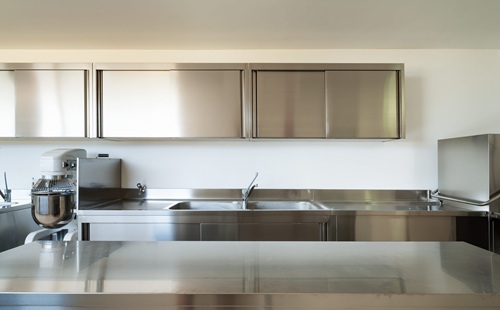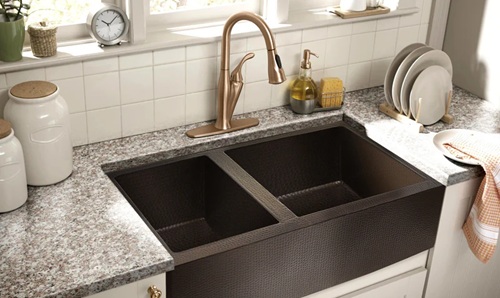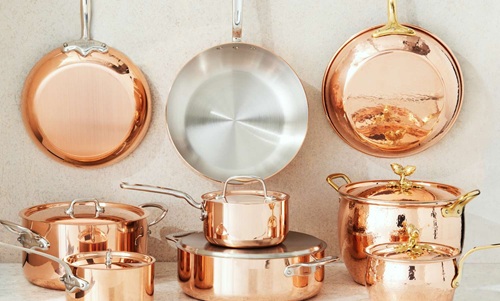When designing or remodeling a kitchen, choosing the right countertop is one of the most important decisions a homeowner can make. The countertop not only defines the kitchen’s aesthetics but also determines how it will function during everyday tasks like meal prep, cooking, and cleaning. Among the many options available — granite, quartz, marble, laminate, and butcher block — stainless steel countertops stand out as a sleek, professional, and hygienic choice.
Long used in commercial kitchens, stainless steel countertops are now making their way into stylish, modern homes. But are they right for your space? Lets explore the pros and cons of stainless steel countertops to help you decide whether this material belongs in your kitchen.

What Are Stainless Steel Countertops?
Stainless steel countertops are typically made from 304-grade stainless steel — the same material used in professional cookware and restaurant kitchens. The steel sheet is wrapped over a wooden or metal core to add structural support. These countertops often feature integrated backsplashes and sinks, creating a seamless surface that is both attractive and functional.
Available in brushed, satin, or mirror finishes, stainless steel countertops suit a range of kitchen styles, from ultra-modern to industrial chic.
Pros of Stainless Steel Countertops
1. Exceptional Durability
Stainless steel is incredibly durable and resistant to heat, water, and stains. It does not crack, chip, or break under normal kitchen conditions. Whether you’re placing a hot pot directly on the surface or dealing with frequent spills, stainless steel can handle it all.
Fact Check: 304 stainless steel is composed of 18% chromium and 8% nickel, which provides excellent corrosion resistance and makes it ideal for high-moisture environments.
2. Hygienic and Non-Porous
One of the top reasons commercial kitchens use stainless steel is because it’s non-porous — meaning it doesn’t absorb liquids, bacteria, or odors. This makes it an ideal choice for food safety and cleanliness.
Tip: Wipe the surface with a soft cloth and mild detergent to keep it sanitized. It’s also bleach-safe in small, diluted quantities.
3. Heat and Fire Resistance
Stainless steel countertops are highly resistant to heat. You can place hot pans, baking trays, or boiling pots directly on the surface without worrying about burn marks or thermal damage.
4. Modern, Industrial Aesthetic
Stainless steel gives your kitchen a sleek, contemporary look. It complements both minimalist and high-tech kitchen designs and pairs well with stainless steel appliances.
Design Tip: Combine with matte black or wood cabinetry for a balanced and stylish contrast.
5. Seamless Integration with Sinks and Appliances
Many stainless steel countertops can be fabricated with an integrated sink and backsplash, minimizing crevices where grime and bacteria can collect. This seamless design improves hygiene and makes cleaning easier.
6. Reflective Qualities Enhance Light
The reflective surface of stainless steel countertops can make a small or dimly lit kitchen feel brighter and more spacious by bouncing light around the room.
7. Long Lifespan
With proper care, stainless steel countertops can last 20–30 years or more. They are resistant to corrosion and don’t degrade over time like some natural stones or laminates.
Cons of Stainless Steel Countertops
1. Prone to Scratches
While durable, stainless steel is not scratch-proof. Over time, regular use of knives, utensils, and pans can leave visible scratch marks, especially in high-gloss or mirror finishes.
Fact Check: Brushed or satin finishes are better at hiding minor abrasions compared to mirror-finish steel, which highlights every imperfection.
2. Shows Smudges and Fingerprints
Stainless steel surfaces are known to show fingerprints, water spots, and smudges easily — especially in households with kids or heavy use. Frequent wiping is necessary to keep the surface looking clean.
Tip: Use a microfiber cloth and stainless steel cleaner or vinegar to reduce smudging and maintain shine.
3. Noisy Surface
When placing utensils or cookware on a stainless steel countertop, the sound can be loud and clanky. It doesn’t absorb noise the way materials like wood or quartz do, which might be a concern in quiet kitchens.
4. Cold and Industrial Feel
Though sleek and modern, some homeowners feel that stainless steel lacks the warmth and texture of natural materials like wood or stone. It can feel too sterile or clinical, especially in traditional-style homes.
Design Fix: Soften the look with warm-toned accents, textured backsplashes, or soft lighting.
5. Can Dent Under Impact
Although steel is tough, it can dent if struck hard by heavy objects — especially in thinner gauge steel or unsupported areas.
Recommendation: Opt for countertops made from 14- or 16-gauge steel, which are thicker and more resistant to denting.
6. Higher Cost Compared to Some Materials
Stainless steel countertops are more expensive than laminate or butcher block but can be competitive with quartz and granite. Costs also rise if custom fabrication or integrated sinks are involved.
Fact Check: In India, stainless steel countertops typically range from ₹1,500 to ₹3,000 per square foot. In the U.S., expect to pay $80 to $150 per square foot installed.
Comparison: Stainless Steel vs. Other Countertop Materials
| Feature | Stainless Steel | Granite | Quartz | Laminate | Butcher Block |
| Durability | Excellent | High | High | Moderate | Moderate |
| Heat Resistance | Excellent | Very Good | Good | Poor | Fair |
| Maintenance | Easy | Moderate (needs sealing) | Easy | Very Easy | Requires oiling |
| Scratch Resistance | Moderate | Very Good | Very Good | Poor | Poor |
| Appearance | Modern, industrial | Natural, elegant | Modern, versatile | Variety of colors | Warm, rustic |
| Cost | Medium-High | High | High | Low | Medium |
| Hygiene | Excellent | Good | Good | Fair | Fair |
Is Stainless Steel the Right Choice for Your Kitchen?
Choose Stainless Steel Countertops If:
- You prioritize cleanliness and food safety.
- You want a modern, professional-looking kitchen.
- You cook frequently and need a surface that withstands heat, water, and wear.
- You’re pairing with integrated sinks or stainless appliances for a unified design.
Avoid Stainless Steel Countertops If:
- You prefer a warm, cozy, or rustic look in your kitchen.
- You’re concerned about visible scratches or fingerprints.
- You want a quiet, textured, or softer feel under your hands.
- You’re on a tight budget and prefer low-cost alternatives like laminate.
Final Verdict
Stainless steel countertops offer unmatched hygiene, durability, and modern appeal — perfect for serious home cooks, contemporary kitchens, and those who appreciate low-maintenance surfaces. While they may show scratches and fingerprints over time, these “imperfections” can even add character, much like a seasoned cutting board.
If you’re aiming for a professional-grade, easy-to-clean, and heat-resistant kitchen, stainless steel countertops are an excellent, long-lasting investment.

